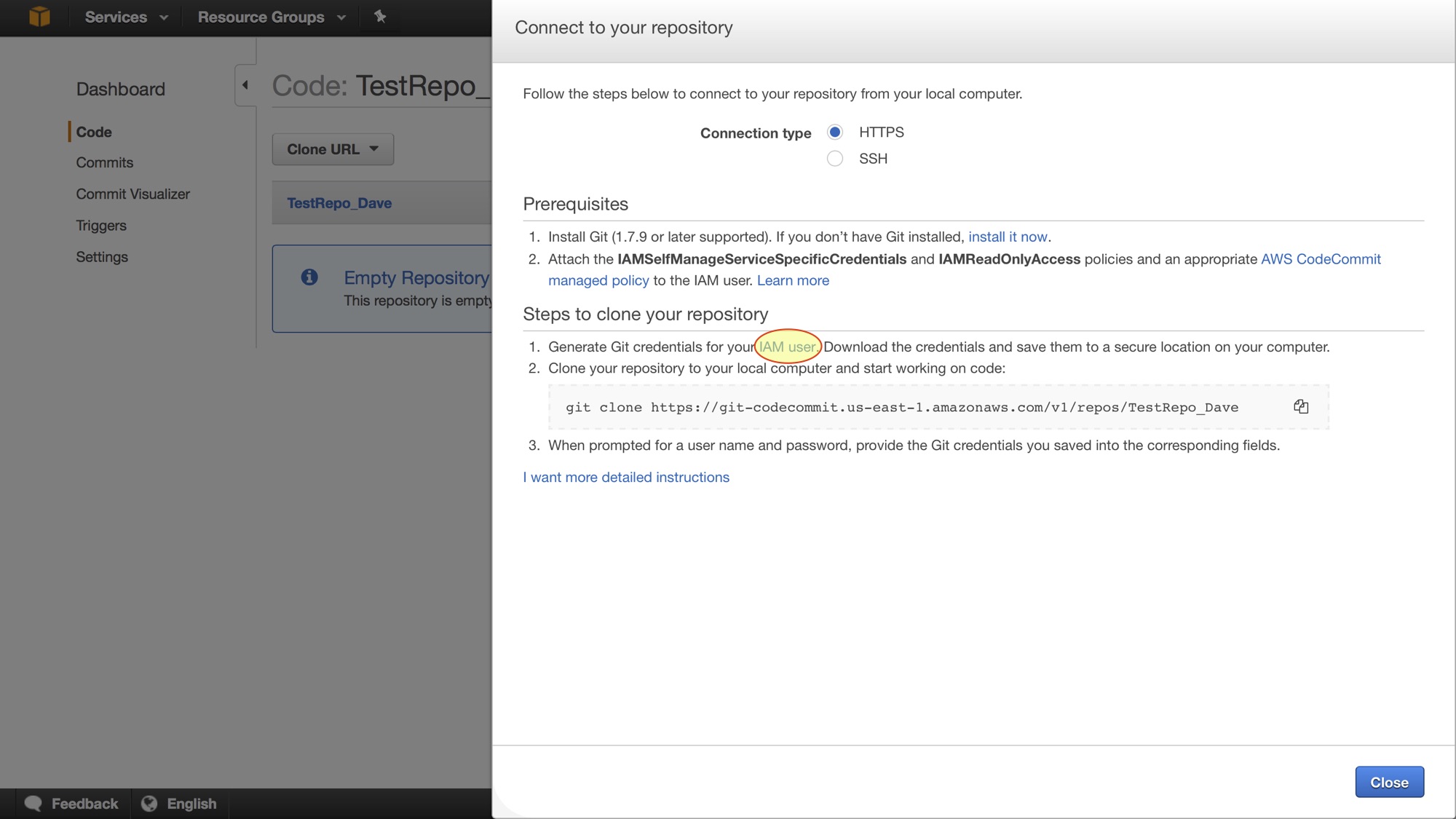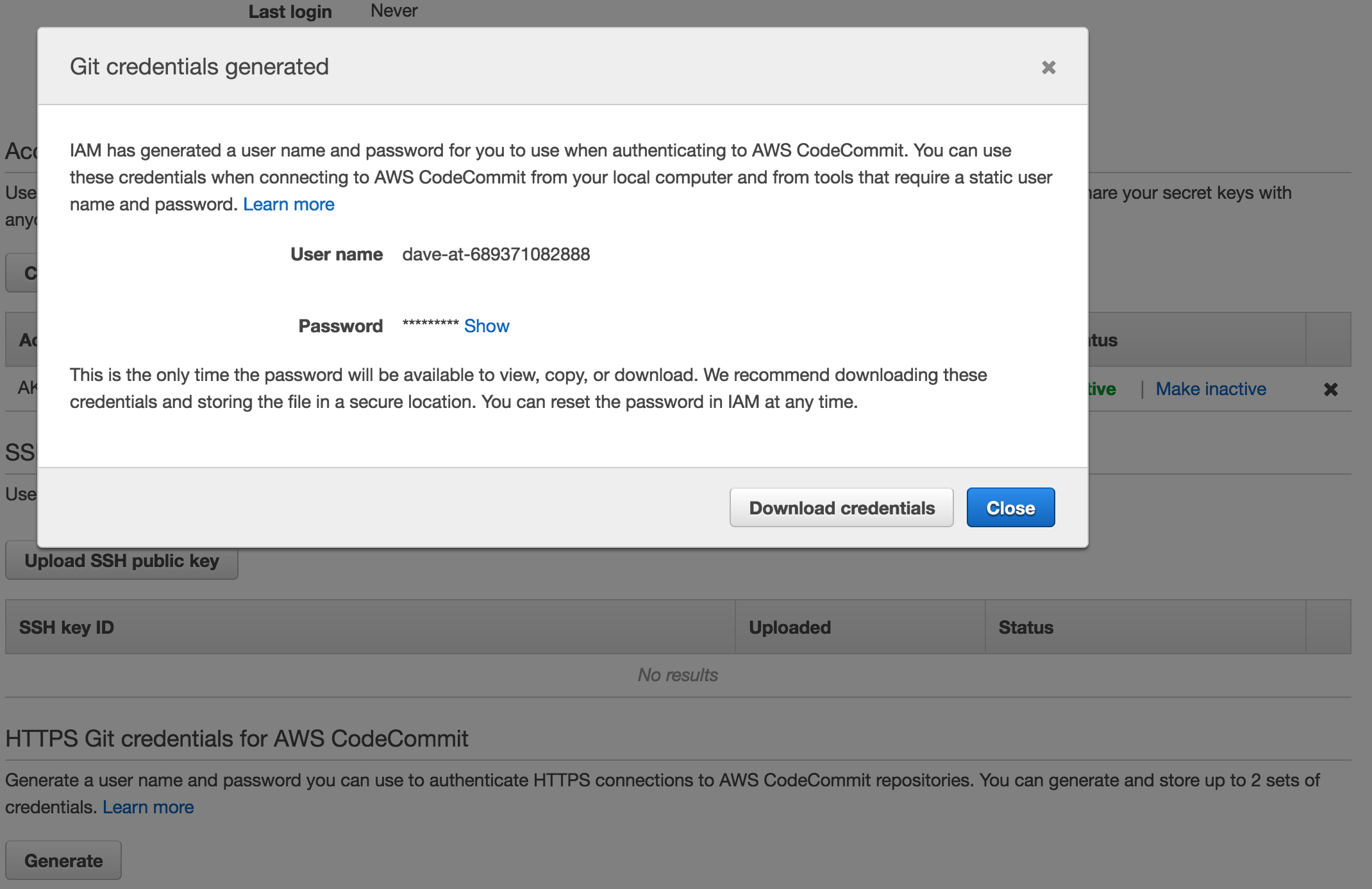AWS DevOps Blog
Introducing Git Credentials: A Simple Way to Connect to AWS CodeCommit Repositories Using a Static User Name and Password
Today, AWS is introducing a simplified way to authenticate to your AWS CodeCommit repositories over HTTPS.
With Git credentials, you can generate a static user name and password in the Identity and Access Management (IAM) console that you can use to access AWS CodeCommit repositories from the command line, Git CLI, or any Git tool that supports HTTPS authentication.
Because these are static credentials, they can be cached using the password management tools included in your local operating system or stored in a credential management utility. This allows you to get started with AWS CodeCommit within minutes. You don’t need to download the AWS CLI or configure your Git client to connect to your AWS CodeCommit repository on HTTPS. You can also use the user name and password to connect to the AWS CodeCommit repository from third-party tools that support user name and password authentication, including popular Git GUI clients (such as TowerUI) and IDEs (such as Eclipse, IntelliJ, and Visual Studio).
So, why did we add this feature? Until today, users who wanted to use HTTPS connections were required to configure the AWS credential helper to authenticate their AWS CodeCommit operations. Customers told us our credential helper sometimes interfered with password management tools such as Keychain Access and Windows Vault, which caused authentication failures. Also, many Git GUI tools and IDEs require a static user name and password to connect with remote Git repositories and do not support the credential helper.
In this blog post, I’ll walk you through the steps for creating an AWS CodeCommit repository, generating Git credentials, and setting up CLI access to AWS CodeCommit repositories.
Git Credentials Walkthrough
Let’s say Dave wants to create a repository on AWS CodeCommit and set up local access from his computer.
Prerequisite: If Dave had previously configured his local computer to use the credential helper for AWS CodeCommit, he must edit his .gitconfig file to remove the credential helper information from the file. Additionally, if his local computer is running macOS, he might need to clear any cached credentials from Keychain Access.
With Git credentials, Dave can now create a repository and start using AWS CodeCommit in four simple steps.
Step 1: Make sure the IAM user has the required permissions
Dave must have the following managed policies attached to his IAM user (or their equivalent permissions) before he can set up access to AWS CodeCommit using Git credentials.
- AWSCodeCommitPowerUser (or an appropriate CodeCommit managed policy)
- IAMSelfManageServiceSpecificCredentials
- IAMReadOnlyAccess
Step 2: Create an AWS CodeCommit repository
Next, Dave signs in to the AWS CodeCommit console and create a repository, if he doesn’t have one already. He can choose any repository in his AWS account to which he has access. The instructions to create Git credentials are shown in the help panel. (Choose the Connect button if the instructions are not displayed.) When Dave clicks the IAM user link, the IAM console will open and he can generate the credentials.

Step 3: Create HTTPS Git credentials in the IAM console
On the IAM user page, Dave selects the Security Credentials tab and clicks Generate under HTTPS Git credentials for AWS CodeCommit section. This creates and displays the user name and password. Dave can then download the credentials.

Note: This is the only time the password is available to view or download.
Step 4: Clone the repository on the local machine
On the AWS CodeCommit console page for the repository, Dave chooses Clone URL, and then copy the HTTPS link for cloning the repository. At the command line or terminal, Dave will use the link he just copied to clone the repository. For example, Dave copies:

And then at the command line or terminal, Dave types:
$ git clone https://git-codecommit.us-east-1.amazonaws.com/v1/repos/TestRepo_Dave
When prompted for user name and password, Dave provides the Git credentials (user name and password) he generated in step 3.
Dave is now ready to start pushing his code to the new repository.
Git credentials can be made active or inactive based on your requirements. You can also reset the password if you would like to use the existing username with a new password.
Next Steps
- You can optionally cache your credentials using the Git credentials caching command here.
- Want to invite a collaborator to work on your AWS CodeCommit repository? Simply create a new IAM user in your AWS account, create Git credentials for that user, and securely share the repository URL and Git credentials with the person you want to collaborate on the repositories.
- Connect to any third-party client that supports connecting to remote Git repositories using Git credentials (a stored user name and password). Virtually all tools and IDEs allow you to connect with static credentials. We’ve tested these:
- Visual Studio (using the default Git plugin)
- Eclipse IDE (using the default Git plugin)
- Git Tower UI
For more information, see the AWS CodeCommit documentation.
We are excited to provide this new way of connecting to AWS CodeCommit. We look forward to hearing from you about the many different tools and IDEs you will be able to use with your AWS CodeCommit repositories.